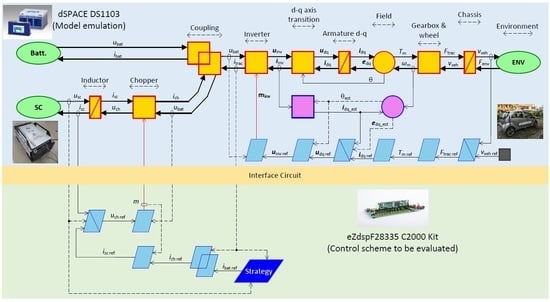A Comparative Study of Adaptive Filtering Strategies for Hybrid Energy Storage Systems in Electric Vehicles
Abstract
:1. Introduction
- An approach for adapting the filtering EMS considering the current “ability” of the SC was proposed. The “ability” of the SC was determined in three ways: energy-based, SOC-based, and voltage-based;
- A comprehensive comparative analysis was conducted to figure out the advantages of the voltage-based and SOC-based EMS over the conventional low-pass filter (LPF) with a fixed cut-off frequency;
- The proposed EMS required low computational effort, which enabled the implementation in an onboard microcontroller. Hence, the strategy can be practically realized on the electronic control unit (ECU) of real vehicles.
2. Modeling of a Battery/Supercapacitor Electric Vehicle
2.1. System Configuration
2.2. Vehicle Traction System
2.2.1. Voltage Source Inverter Modeling
2.2.2. IPMSM Modeling
2.2.3. Gearbox and Wheels’ Modeling
2.2.4. Chassis Modeling
2.2.5. Environment
2.3. Hybrid Energy Storage System
2.3.1. Battery Modeling
2.3.2. Supercapacitor Modeling
2.3.3. Bidirectional DC/DC Converter Modeling
2.3.4. DC Bus Modeling
3. Control and Energy Management
3.1. Local Control
- Conversion elements were inverted by basic algebraic computation;
- Accumulation elements inversions were performed by the feedback control design;
- The coupling elements were inverted with inputs from the strategy block, which resulted in the required energy distribution.
3.1.1. Control of the Traction System
3.1.2. Control of the HESS
3.2. Proposed Energy Management Strategies
3.2.1. Adaptive Filtering Strategies
- SC energy-based strategy:
- SC SOC-based strategy:
- SC voltage-based strategy:
3.2.2. SC Voltage Limitation Algorithm
4. Comparative Results and Discussions
4.1. Evaluation Scenarios
4.2. Offline Simulation Results and Discussions
4.3. Real-Time Ability Validation by the Signal HIL Experiment
4.3.1. Experimental System Setup
4.3.2. Results and Discussion
5. Conclusions
Author Contributions
Funding
Institutional Review Board Statement
Informed Consent Statement
Acknowledgments
Conflicts of Interest
Abbreviations
| HESS | Hybrid energy storage system |
| EMS | Energy management strategy |
| SC | Supercapacitor |
| LQR | Linear quadratic regulation |
| HESS | Hybrid energy storage system |
| EMS | Energy management strategy |
| SC | Supercapacitor |
| HESS | Hybrid energy storage system |
| EMS | Energy management strategy |
| SC | Supercapacitor |
| LQR | Linear quadratic regulation |
| PMP | Pontryagin’s minimum principle |
| EMR | Energetic macroscopic representation |
| IPMSM | Interior permanent magnet synchronous motor |
| SOC | State-of-charge |
| AFS | Adaptive filtering strategy |
| NEDC | New European Driving Cycle |
| AUDC | Artemis Urban Driving Cycle |
| WLTC | Worldwide harmonized Light vehicles Test Cycles |
| ECU | Electronic control unit |
Appendix A

References
- Barré, A.; Deguilhem, B.; Grolleau, S.; Gérard, M.; Suard, F.; Riu, D. A review on lithium-ion battery ageing mechanisms and estimations for automotive applications. J. Power Sources 2013, 241, 680–689. [Google Scholar] [CrossRef] [Green Version]
- Ma, S.; Jiang, M.; Tao, P.; Song, C.; Wu, J.; Wang, J.; Deng, T.; Shang, W. Temperature effect and thermal impact in lithium-ion batteries: A review. Prog. Nat. Sci. Mater. Int. 2018, 28, 653–666. [Google Scholar] [CrossRef]
- Han, X.; Lu, L.; Zheng, Y.; Feng, X.; Li, Z.; Jianqiu, L.; Ouyang, M. A review on the key issues of the lithium ion battery degradation among the whole life cycle. eTransportation 2019, 1, 100005. [Google Scholar] [CrossRef]
- Tran, D.D.; Vafaeipour, M.; El Baghdadi, M.; Barrero, R.; Van Mierlo, J.; Hegazy, O. Thorough state-of-the-art analysis of electric and hybrid vehicle powertrains: Topologies and integrated energy management strategies. Renew. Sustain. Energy Rev. 2020, 119, 109596. [Google Scholar] [CrossRef]
- Schaltz, E.; Khaligh, A.; Rasmussen, P.O. Influence of Battery/Ultracapacitor Energy-Storage Sizing on Battery Lifetime in a Fuel Cell Hybrid Electric Vehicle. IEEE Trans. Veh. Technol. 2009, 58, 3882–3891. [Google Scholar] [CrossRef]
- Song, Z.; Hofmann, H.; Li, J.; Hou, J.; Han, X.; Ouyang, M. Energy management strategies comparison for electric vehicles with hybrid energy storage system. Appl. Energy 2014, 134, 321–331. [Google Scholar] [CrossRef]
- Trovão, J.P.; Silva, M.A.; Antunes, C.H.; Dubois, M.R. Stability enhancement of the motor drive DC input voltage of an electric vehicle using onboard hybrid energy storage systems. Appl. Energy 2017, 205, 244–259. [Google Scholar] [CrossRef]
- Nguyen, B.H.; German, R.; Trovao, J.P.F.; Bouscayrol, A. Real-time energy management of battery/supercapacitor electric vehicles based on an adaptation of pontryagin’s minimum principle. IEEE Trans. Veh. Technol. 2019, 68, 203–212. [Google Scholar] [CrossRef] [Green Version]
- Vinot, E.; Trigui, R. Optimal energy management of HEVs with hybrid storage system. Energy Convers. Manag. 2013, 76, 437–452. [Google Scholar] [CrossRef] [Green Version]
- Hussain, S.; Ali, M.U.; Nengroo, S.H.; Khan, I.; Ishfaq, M.; Kim, H.J. Semiactive hybrid energy management system: A solution for electric wheelchairs. Electronics 2019, 8, 345. [Google Scholar] [CrossRef] [Green Version]
- Salmasi, F.R. Control Strategies for Hybrid Electric Vehicles: Evolution, Classification, Comparison, and Future Trends. IEEE Trans. Veh. Technol. 2007, 56, 2393–2404. [Google Scholar] [CrossRef]
- Peng, J.; Wang, R.; Liao, H.; Zhou, Y.; Li, H.; Wu, Y.; Huang, Z. A Real-Time Layer-Adaptive Wavelet Transform Energy Distribution Strategy in a Hybrid Energy Storage System of EVs. Energies 2019, 12, 440. [Google Scholar] [CrossRef] [Green Version]
- Thounthong, P.; Rael, S. The benefits of hybridization. IEEE Ind. Electron. Mag. 2009, 3, 25–37. [Google Scholar] [CrossRef]
- Wang, L.; Collins, E.G.; Li, H. Optimal Design and Real-Time Control for Energy Management in Electric Vehicles. IEEE Trans. Veh. Technol. 2011, 60, 1419–1429. [Google Scholar] [CrossRef]
- Rajabzadeh, M.; Bathaee, S.M.T.; Aliakbar Golkar, M. Dynamic modeling and nonlinear control of fuel cell vehicles with different hybrid power sources. Int. J. Hydrog. Energy 2016, 41, 3185–3198. [Google Scholar] [CrossRef]
- Yu, Y.B.; Liu, X.; Min, H.; Sun, H.; Xu, L. A novel fuzzy-logic based control strategy for a semi-active battery/super-capacitor hybrid energy storage system in vehicular applications. J. Intell. Fuzzy Syst. 2015, 29, 2575–2584. [Google Scholar] [CrossRef] [Green Version]
- Wang, Y.; Wang, W.; Zhao, Y.; Yang, L.; Chen, W. A Fuzzy-Logic Power Management Strategy Based on Markov Random Prediction for Hybrid Energy Storage Systems. Energies 2016, 9, 25. [Google Scholar] [CrossRef]
- Xiong, R.; Cao, J.; Yu, Q. Reinforcement learning-based real-time power management for hybrid energy storage system in the plug-in hybrid electric vehicle. Appl. Energy 2017, 211, 538–548. [Google Scholar] [CrossRef]
- Hu, Y.; Li, W.; Xu, K.; Zahid, T.; Qin, F.; Li, C. Energy management strategy for a hybrid electric vehicle based on deep reinforcement learning. Appl. Sci. 2018, 8, 187. [Google Scholar] [CrossRef] [Green Version]
- Adnane, M.; Nguyễn, B.H.; Khoumsi, A.; Trovão, J.P.F. Driving Mode Predictor-based Real-Time Energy Management for Dual-Source Electric Vehicle. IEEE Trans. Transp. Electrif. 2021, 1. [Google Scholar] [CrossRef]
- Trovão, J.P.; Pereirinha, P.G.; Jorge, H.M.; Antunes, C.H. A multi-level energy management system for multi-source electric vehicles—An integrated rule-based meta-heuristic approach. Appl. Energy 2013, 105, 304–318. [Google Scholar] [CrossRef]
- Yao, L.; Damiran, Z.; Lim, W.H. Optimal charging and discharging scheduling for electric vehicles in a parking station with photovoltaic system and energy storage system. Energies 2017, 10, 550. [Google Scholar] [CrossRef]
- Sundstrom, O.; Guzzella, L. A generic dynamic programming Matlab function. In Proceedings of the 2009 IEEE Control Applications, (CCA) & Intelligent Control, (ISIC), St. Petersburg, Russia, 8–10 July 2009; pp. 1625–1630. [Google Scholar] [CrossRef]
- Nguyễn, B.H.; Vo-Duy, T.; Henggeler Antunes, C.; Trovão, J.P.F. Multi-objective benchmark for energy management of dual-source electric vehicles: An optimal control approach. Energy 2021, 223, 119857. [Google Scholar] [CrossRef]
- Nguyễn, B.H.; Vo-Duy, T.; Ta, M.C.; Trovão, J.P.F. Optimal Energy Management of Hybrid Storage Systems Using an Alternative Approach of Pontryagin’s Minimum Principle. IEEE Trans. Transp. Electrif. 2021, 1. [Google Scholar] [CrossRef]
- Nguyen, B.H.; Trovão, J.P.F.; German, R.; Bouscayrol, A. Real-time energy management of parallel hybrid electric vehicles using linear quadratic regulation. Energies 2020, 13, 5538. [Google Scholar] [CrossRef]
- Golchoubian, P.; Azad, N.L. Real-Time Nonlinear Model Predictive Control of a Battery–Supercapacitor Hybrid Energy Storage System in Electric Vehicles. IEEE Trans. Veh. Technol. 2017, 66, 9678–9688. [Google Scholar] [CrossRef]
- Zhang, Y.; Liu, H.; Zhang, Z.; Luo, Y.; Guo, Q.; Liao, S. Cloud computing-based real-time global optimization of battery aging and energy consumption for plug-in hybrid electric vehicles. J. Power Sources 2020, 479, 229069. [Google Scholar] [CrossRef]
- Trovão, J.P.; Silva, M.A.; Dubois, M.R. Coupled energy management algorithm for MESS in urban EV. IET Electr. Syst. Transp. 2017, 7, 125–134. [Google Scholar] [CrossRef]
- Asensio, E.M.; Magallán, G.A.; De Angelo, C.H.; Serra, F.M. Energy Management on Battery/Ultracapacitor Hybrid Energy Storage System based on Adjustable Bandwidth Filter and Sliding-mode Control. J. Energy Storage 2020, 30, 101569. [Google Scholar] [CrossRef]
- Allègre, A.L.; Bouscayrol, A.; Trigui, R. Flexible real-time control of a hybrid energy storage system for electric vehicles. IET Electr. Syst. Transp. 2013, 3, 79–85. [Google Scholar] [CrossRef]
- Castaings, A.; Lhomme, W.; Trigui, R.; Bouscayrol, A. Comparison of energy management strategies of a battery/supercapacitors system for electric vehicle under real-time constraints. Appl. Energy 2016, 163, 190–200. [Google Scholar] [CrossRef]
- Snoussi, J.; Ben Elghali, S.; Benbouzid, M.; Mimouni, M.F. Auto-adaptive filtering-based energy management strategy for fuel cell hybrid electric vehicles. Energies 2018, 11, 2118. [Google Scholar] [CrossRef] [Green Version]
- Hussain, S.; Ali, M.U.; Park, G.s.; Nengroo, S.H.; Khan, M.A.; Kim, H.j. A Real-Time Bi-Adaptive Controller-Based Energy Hybrid Electric Vehicles. Energies 2019, 12, 4662. [Google Scholar] [CrossRef] [Green Version]
- Florescu, A.; Bacha, S.; Munteanu, I.; Bratcu, A.I.; Rumeau, A. Adaptive frequency-separation-based energy management system for electric vehicles. J. Power Sources 2015, 280, 410–421. [Google Scholar] [CrossRef]
- Tani, A.; Camara, M.B.; Dakyo, B. Energy Management Based on Frequency Approach for Hybrid Electric Vehicle Applications: Fuel-Cell/Lithium-Battery and Ultracapacitors. IEEE Trans. Veh. Technol. 2012, 61, 3375–3386. [Google Scholar] [CrossRef]
- Vo-Duy, T.; Ta, M.C.; Nguyễn, B.H.; Trovão, J.P.F. Experimental Platform for Evaluation of On-Board Real-Time Motion Controllers for Electric Vehicles. Energies 2020, 13, 6448. [Google Scholar] [CrossRef]
- Bouscayrol, A. Graphic Formalisms for the Control of Multi-Physical Energetic Systems: COG and EMR. In Systemic Design Methodologies for Electrical Energy Systems; Wiley: Hoboken, NJ, USA, 2013; pp. 89–124. [Google Scholar] [CrossRef]
- Nguyen, B.; Trovao, J.P.F.; German, R.; Bouscayrol, A. Impact of Supercapacitors on Fuel Consumption and Battery Current of a Parallel Hybrid Truck. In Proceedings of the 2019 IEEE Vehicle Power and Propulsion Conference (VPPC), Hanoi, Vietnam, 14–17 October 2019; pp. 1–6. [Google Scholar] [CrossRef]
- Dépature, C.; Lhomme, W.; Sicard, P.; Bouscayrol, A.; Boulon, L. Real-Time Backstepping Control for Fuel Cell Vehicle Using Supercapacitors. IEEE Trans. Veh. Technol. 2018, 67, 306–314. [Google Scholar] [CrossRef]
- Vo-Duy, T.; Nguyen, B.H.; Ta, M.C.; Trovão, J.P.; Nguyen, N. Different Voltage and Current Control Schemes for Multi-pack Battery of Electric Scooters. In Proceedings of the 2020 IEEE Vehicle Power and Propulsion Conference (VPPC), Gijon, Spain, 18 November–16 December 2020; pp. 1–5. [Google Scholar] [CrossRef]
- Nam, K. AC Motor Control and Electrical Vehicle Applications, 2nd ed.; CRC Press: Boca Raton, FL, USA, 2018. [Google Scholar] [CrossRef]
- Lee, S.C.; Jung, W.Y. Analogical understanding of the Ragone plot and a new categorization of energy devices. Energy Procedia 2016, 88, 526–530. [Google Scholar] [CrossRef] [Green Version]
- Trovão, J.P.F.; Roux, M.; Ménard, É.; Dubois, M.R. Energy- and Power-Split Management of Dual Energy Storage System for a Three-Wheel Electric Vehicle. IEEE Trans. Veh. Technol. 2017, 66, 5540–5550. [Google Scholar] [CrossRef]
- Nguyen, C.T.P.; Nguyễn, B.H.; Trovão, J.P.F.; Ta, M.C. Effect of battery voltage variation on electric vehicle performance driven by induction machine with optimal flux-weakening strategy. IET Electr. Syst. Transp. 2020, 10, 351–359. [Google Scholar] [CrossRef]


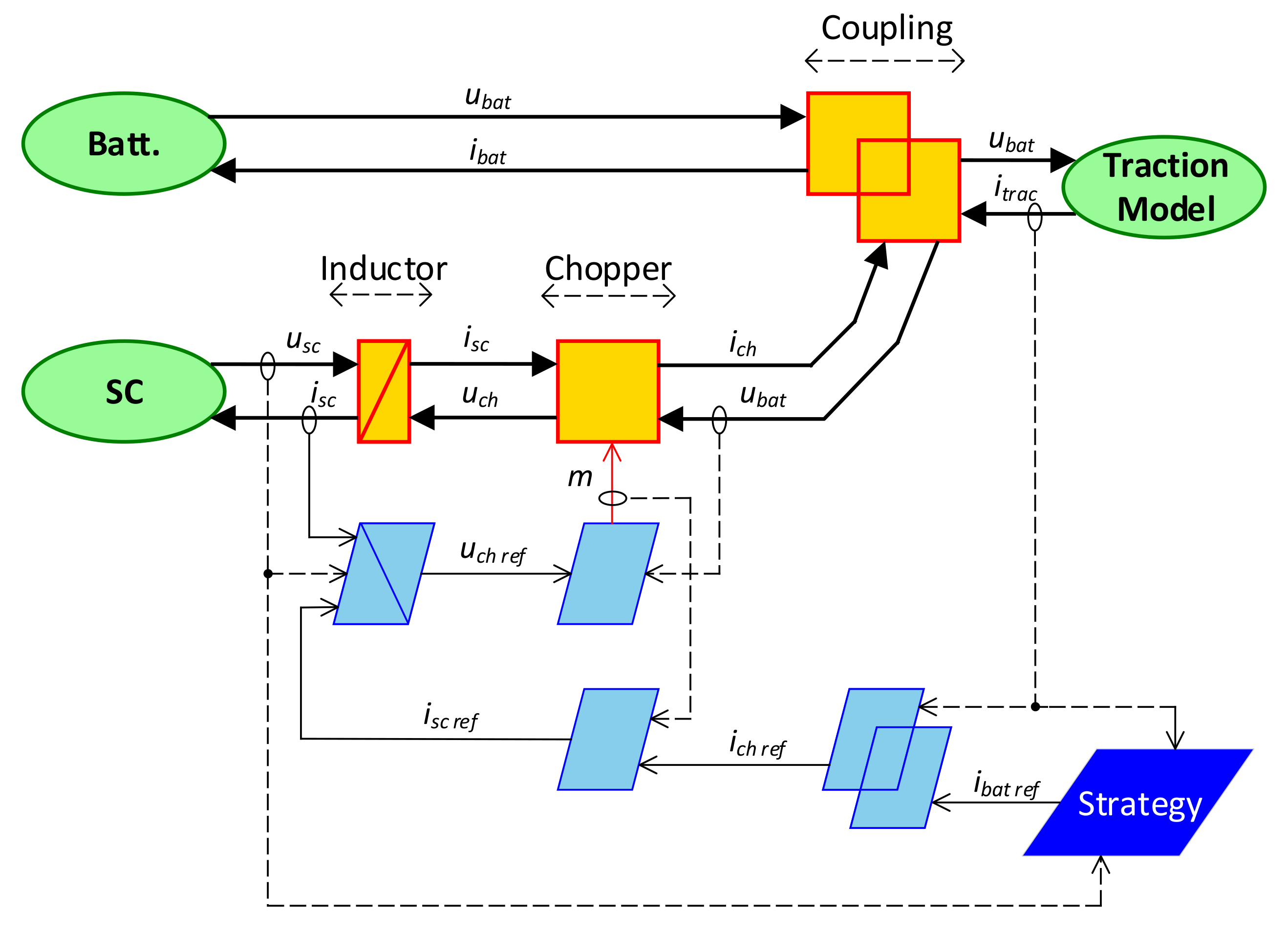

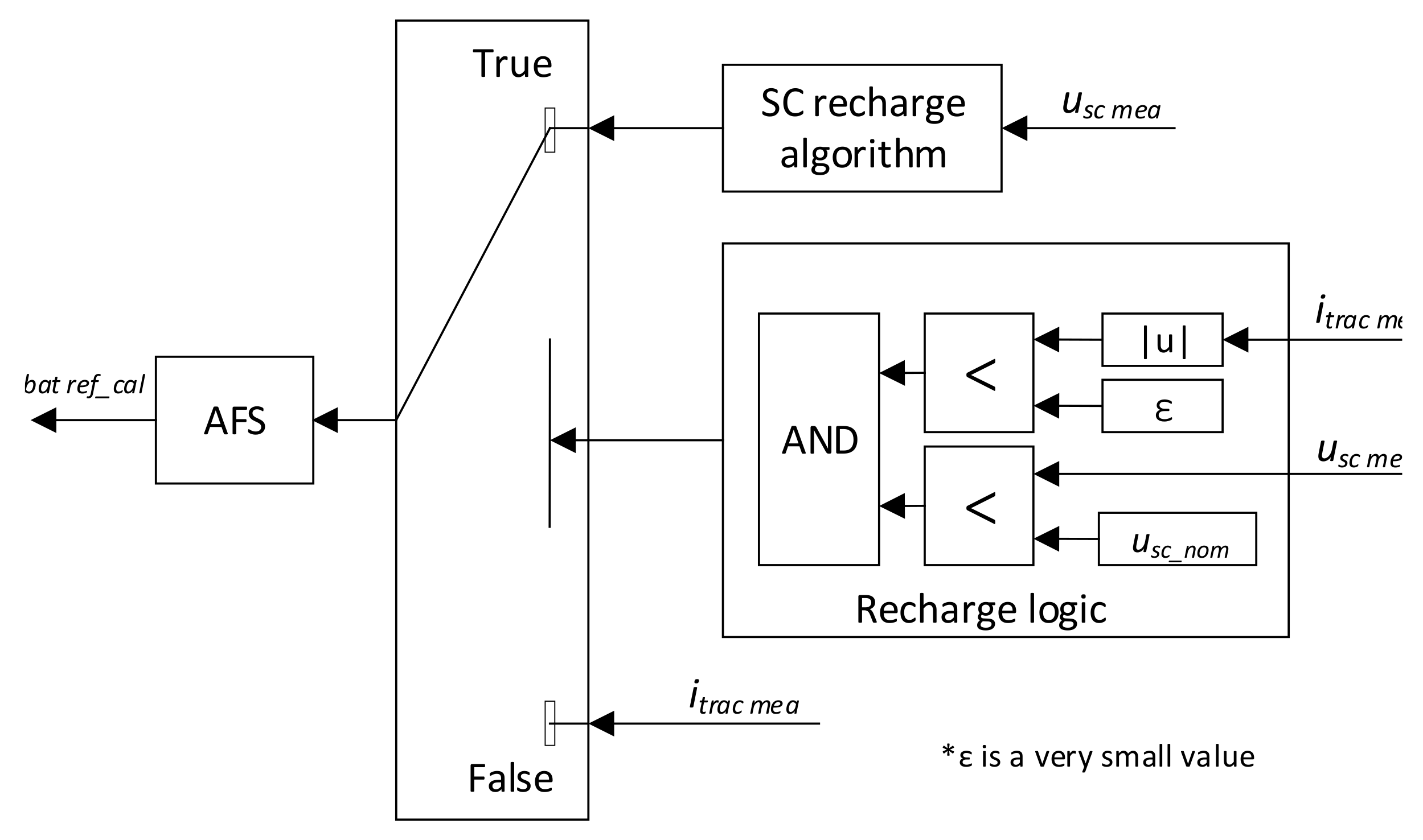
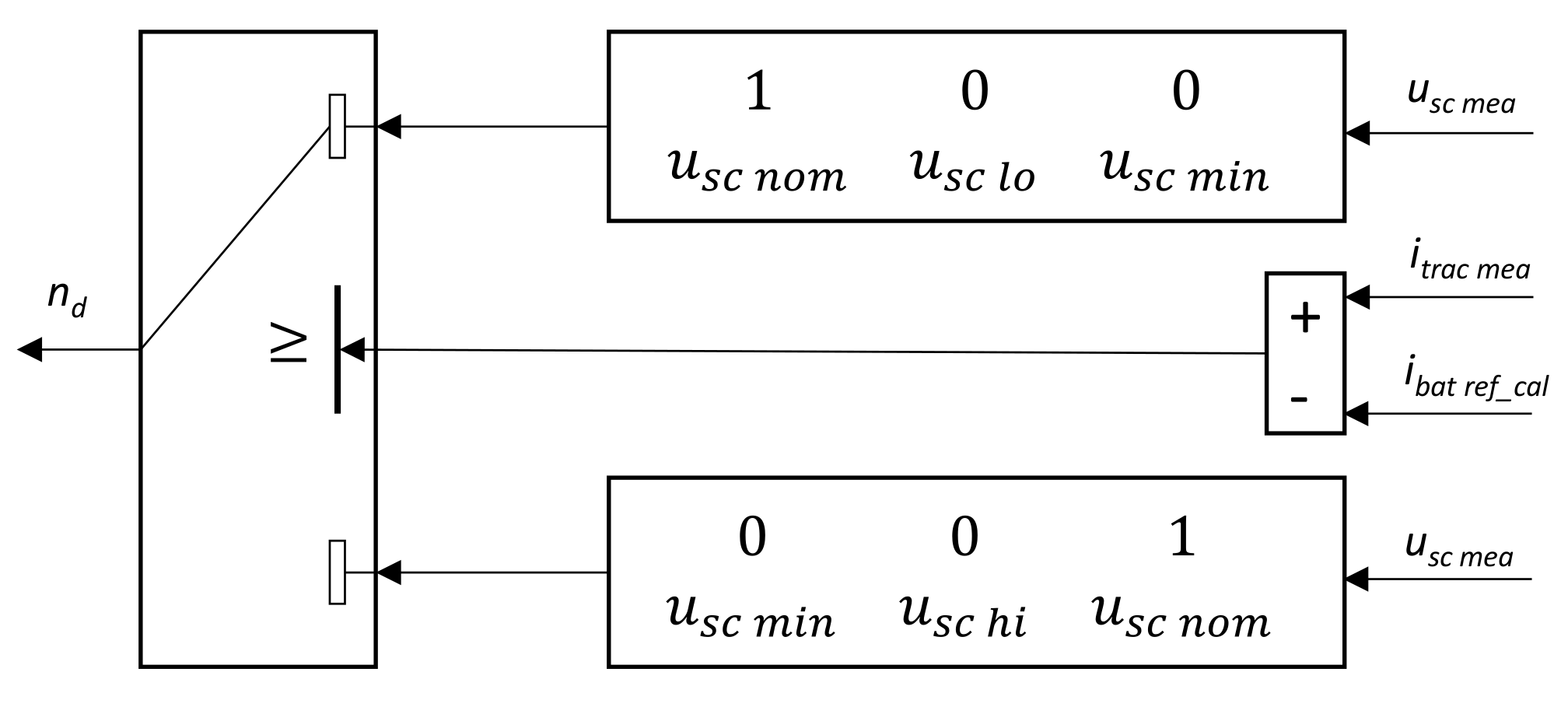

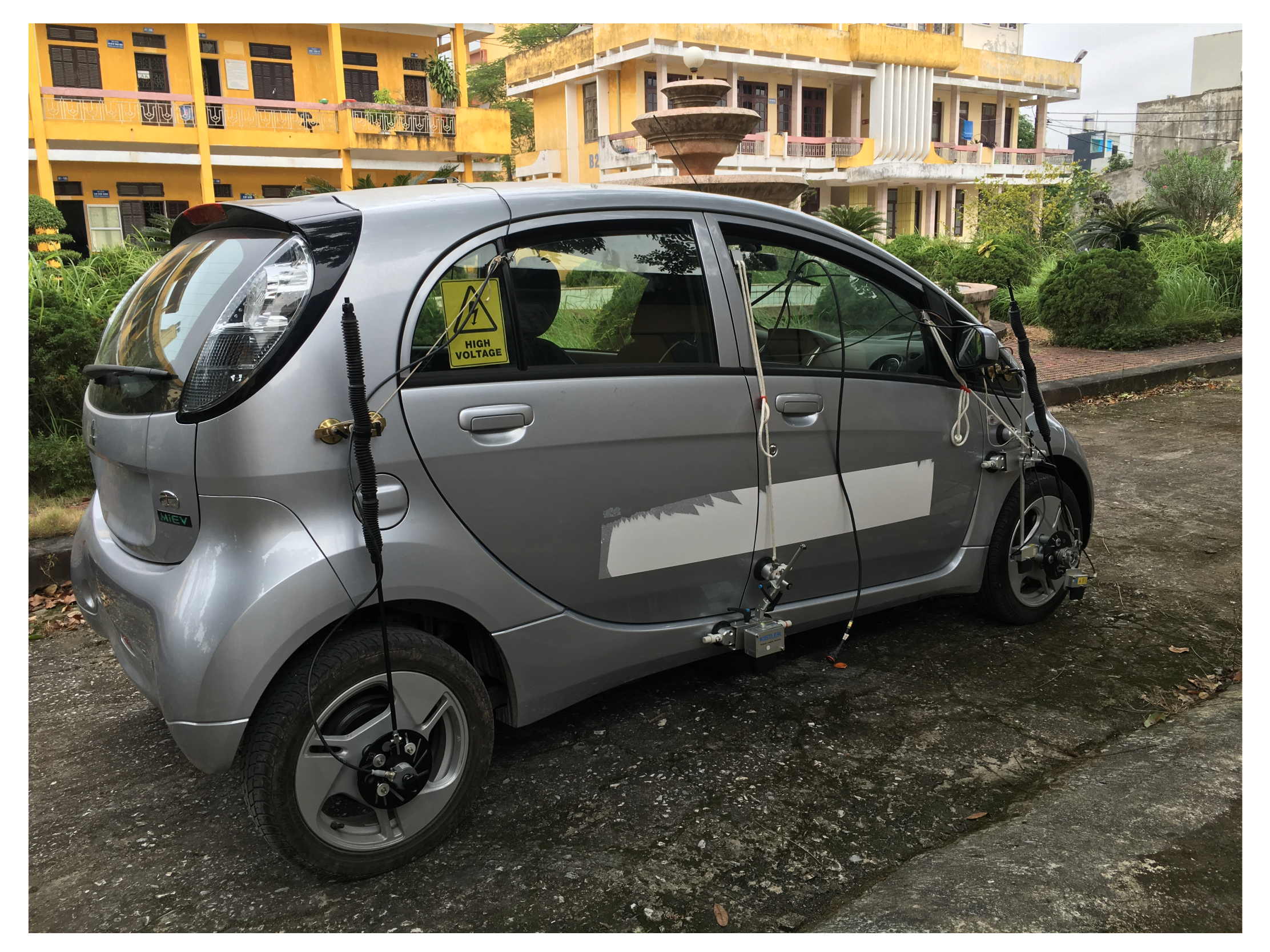
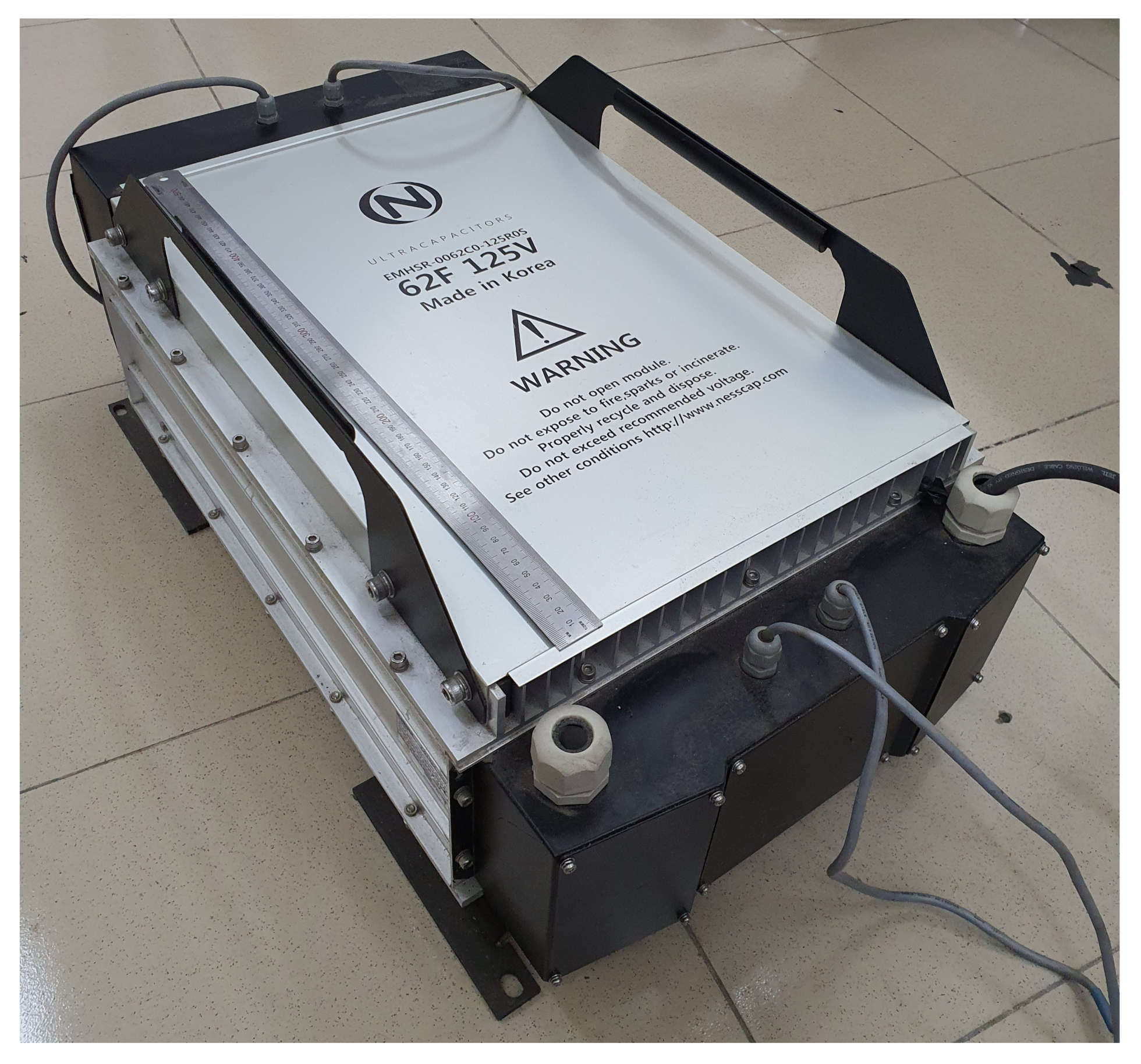
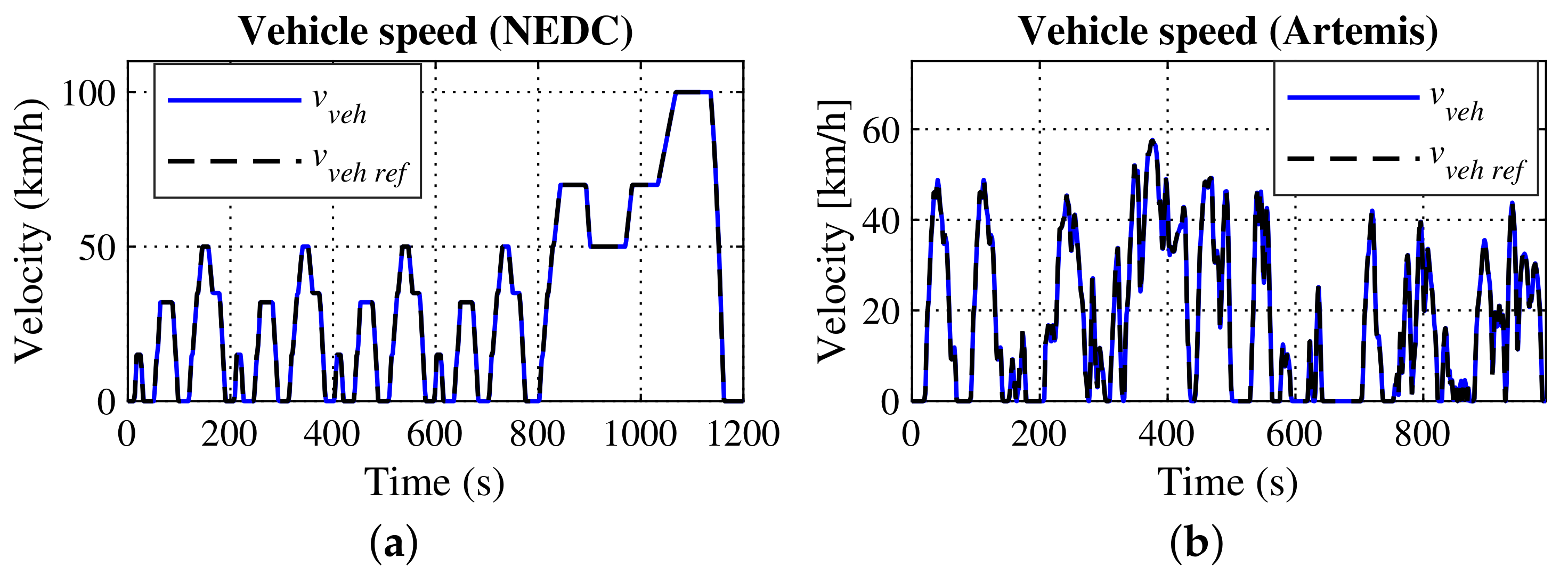

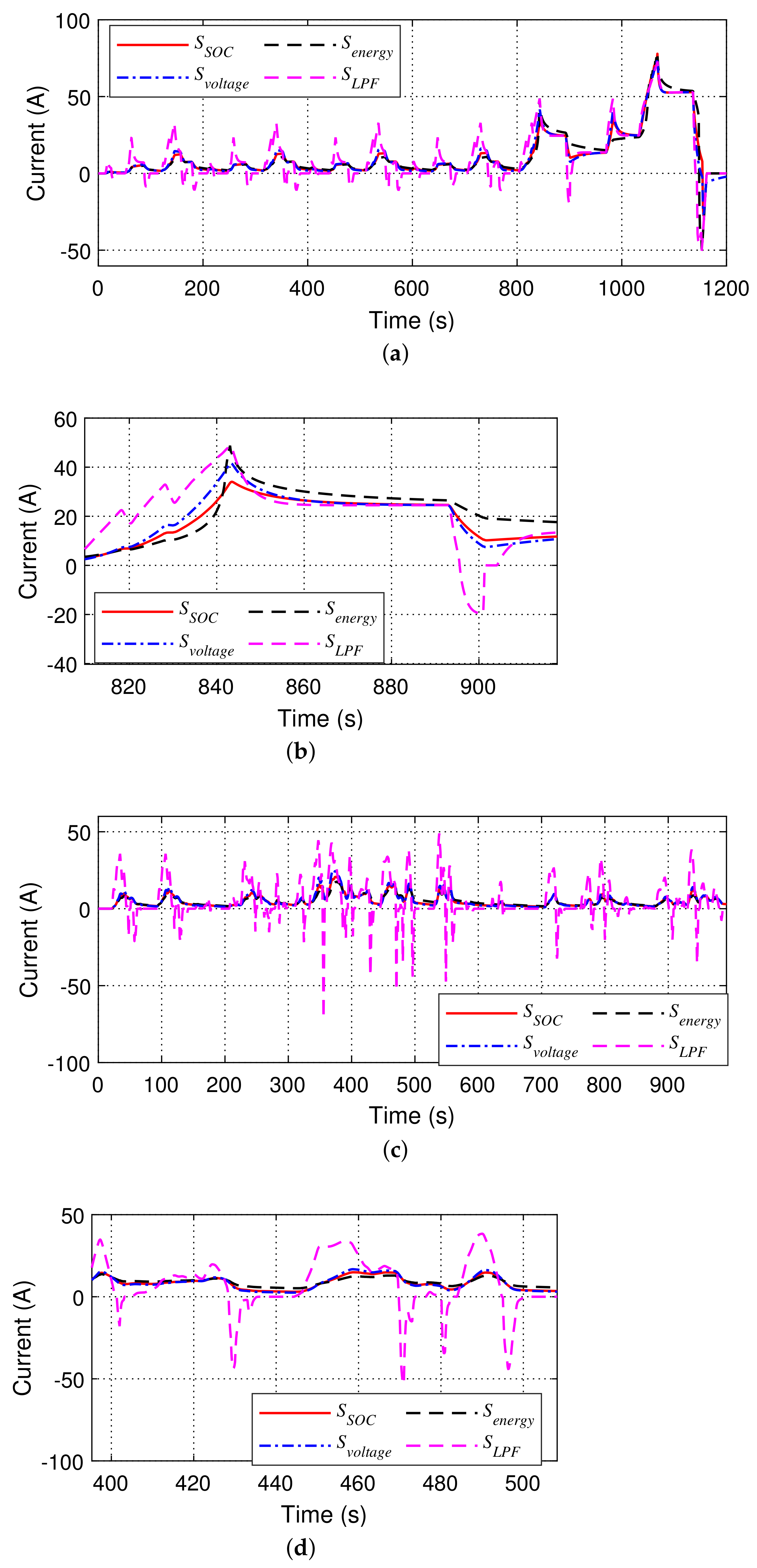
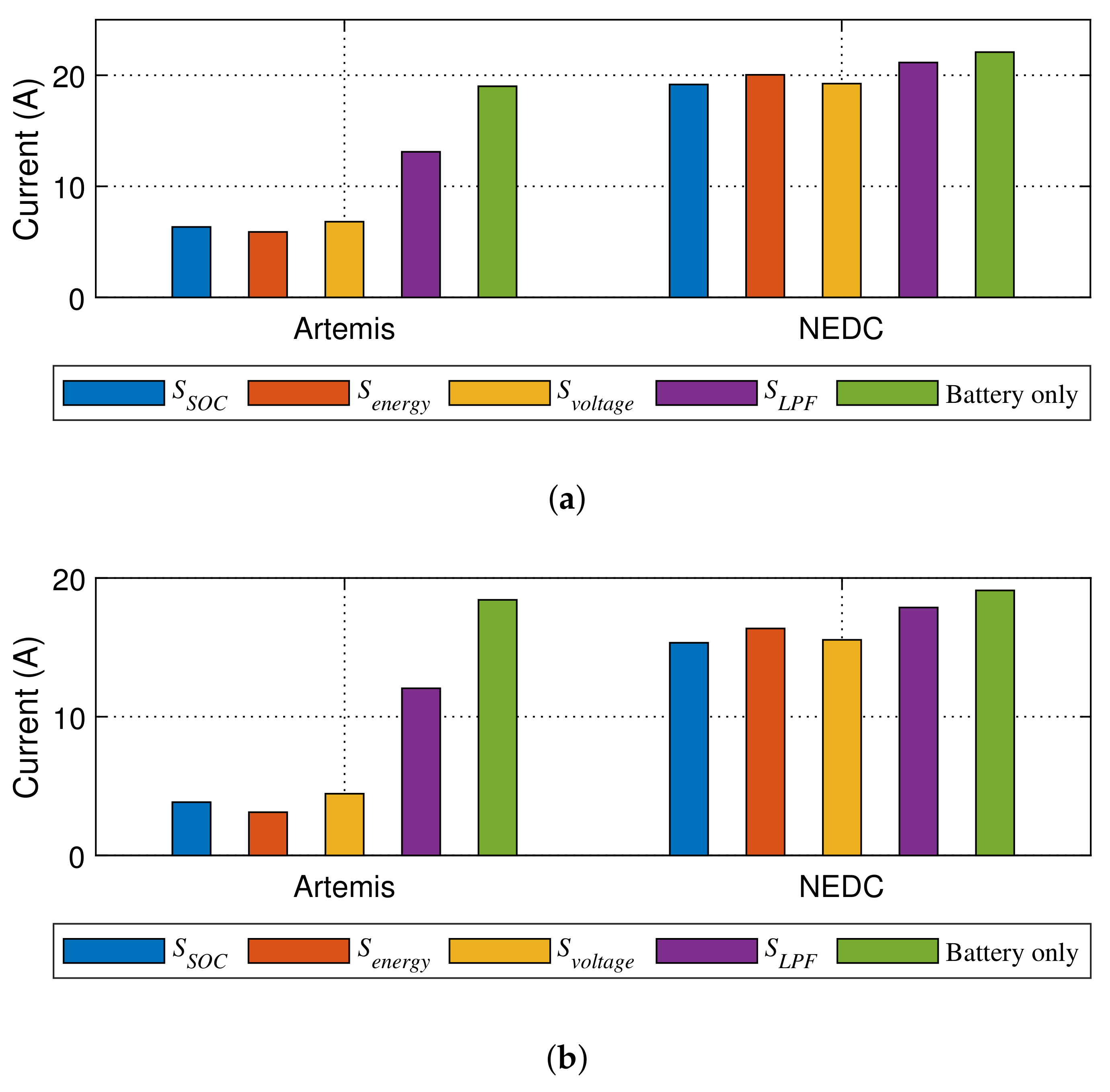

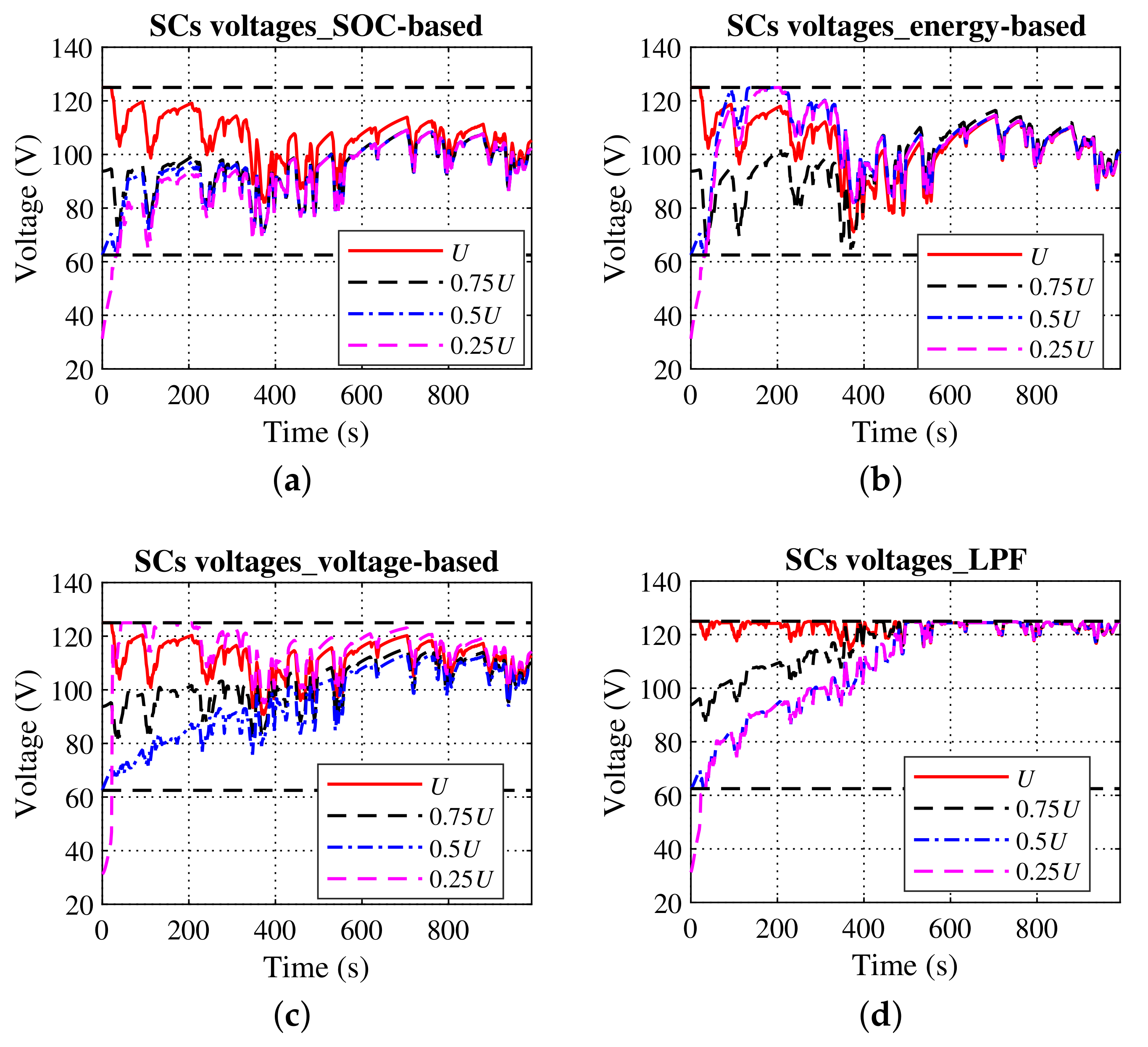
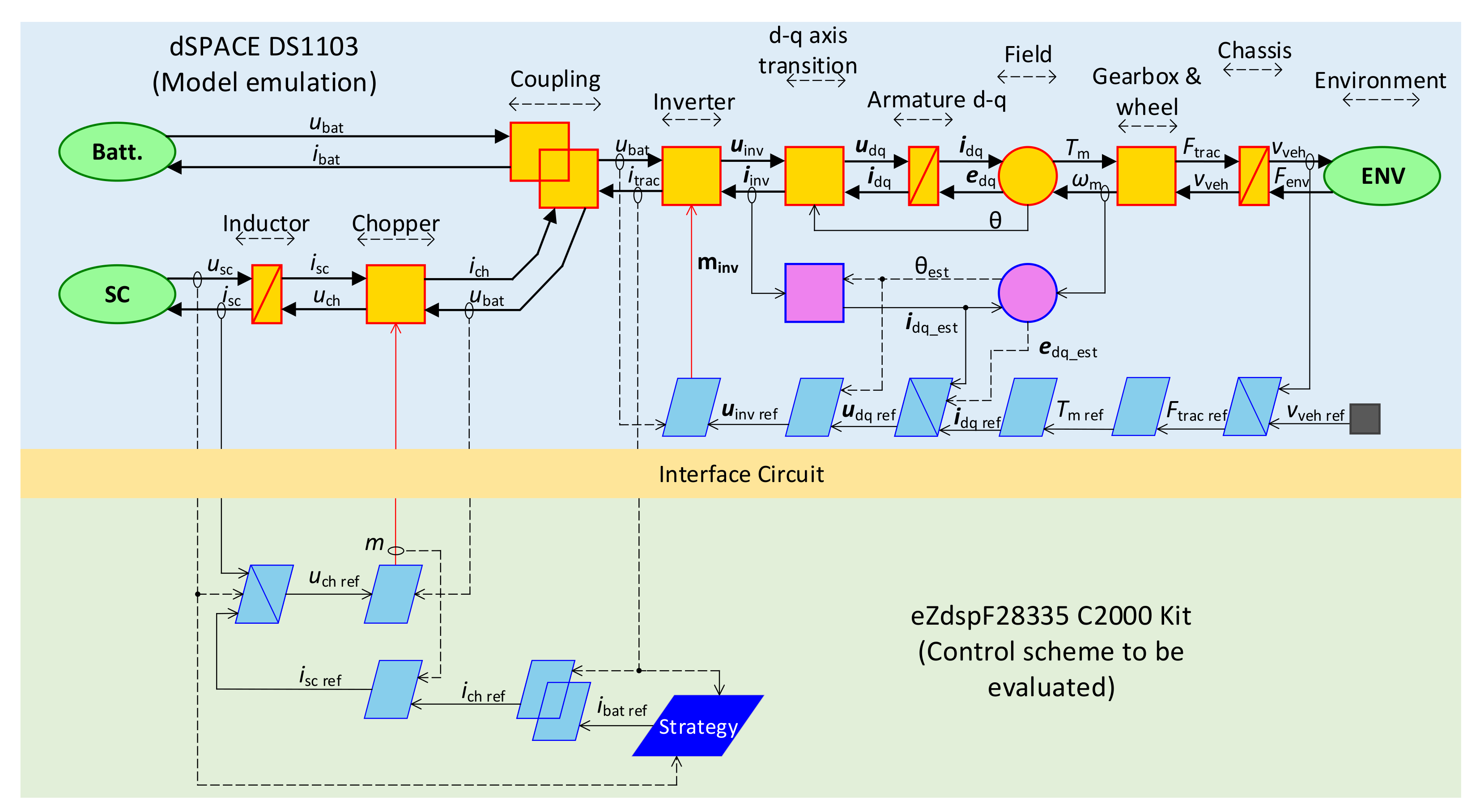
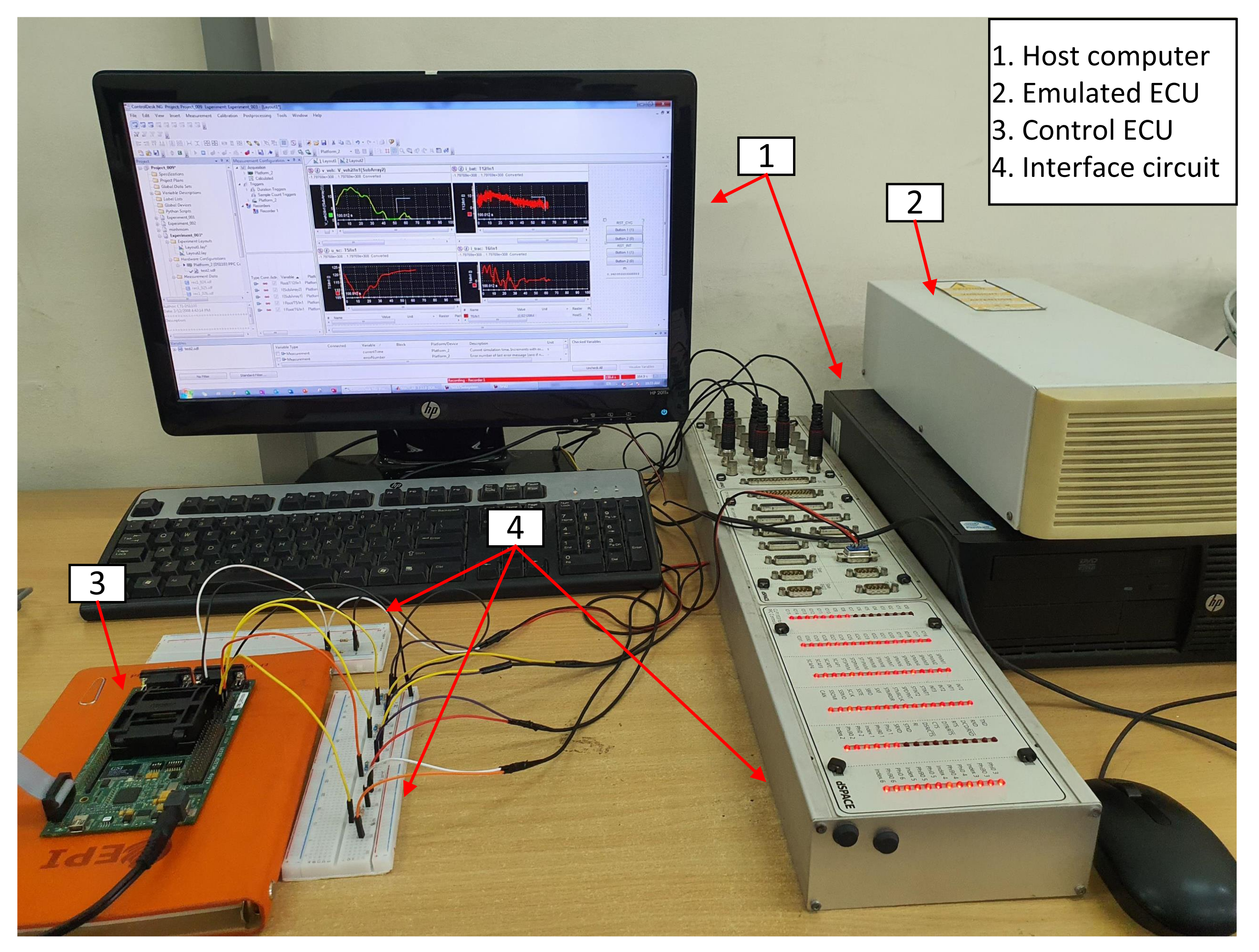

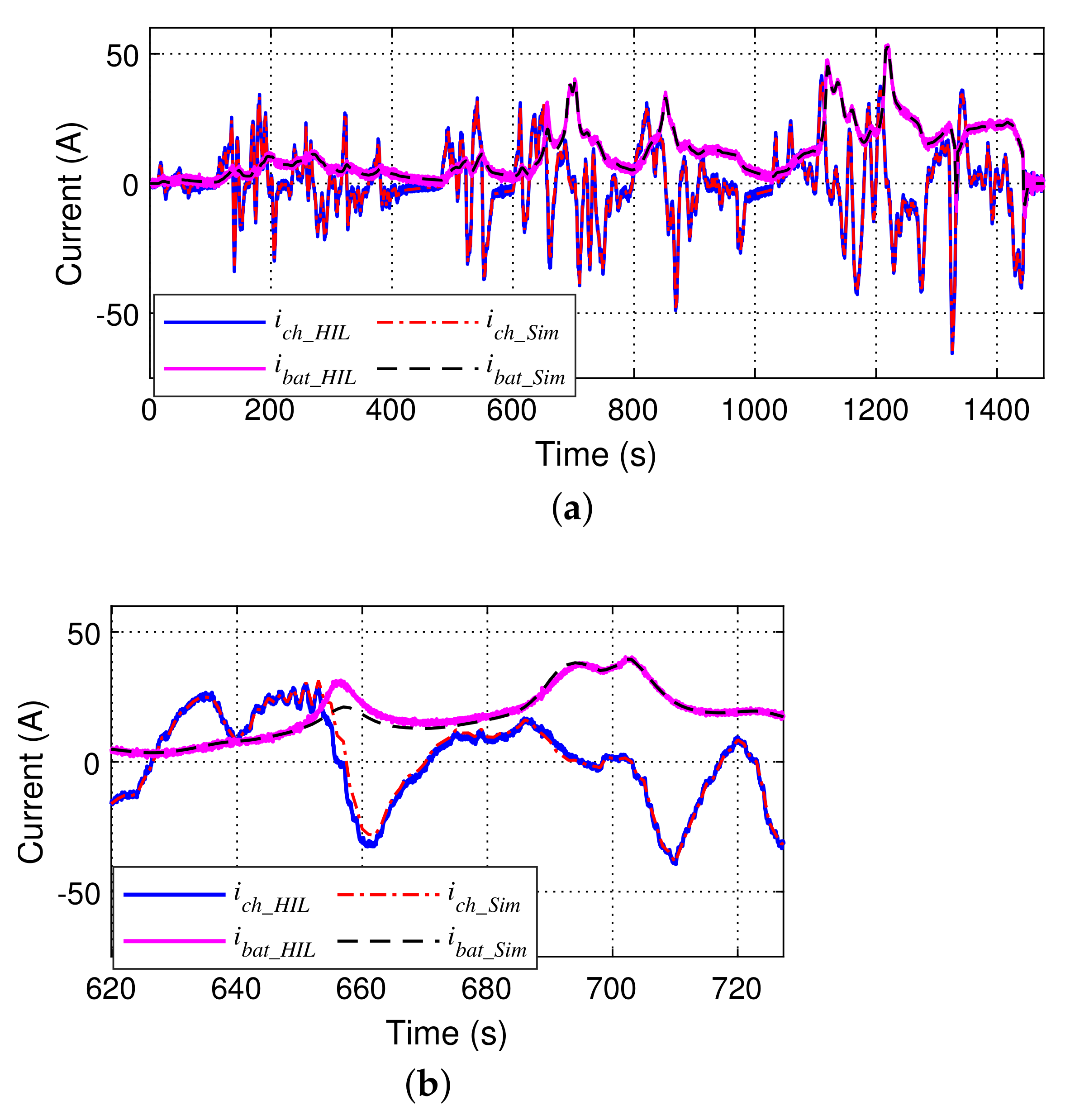
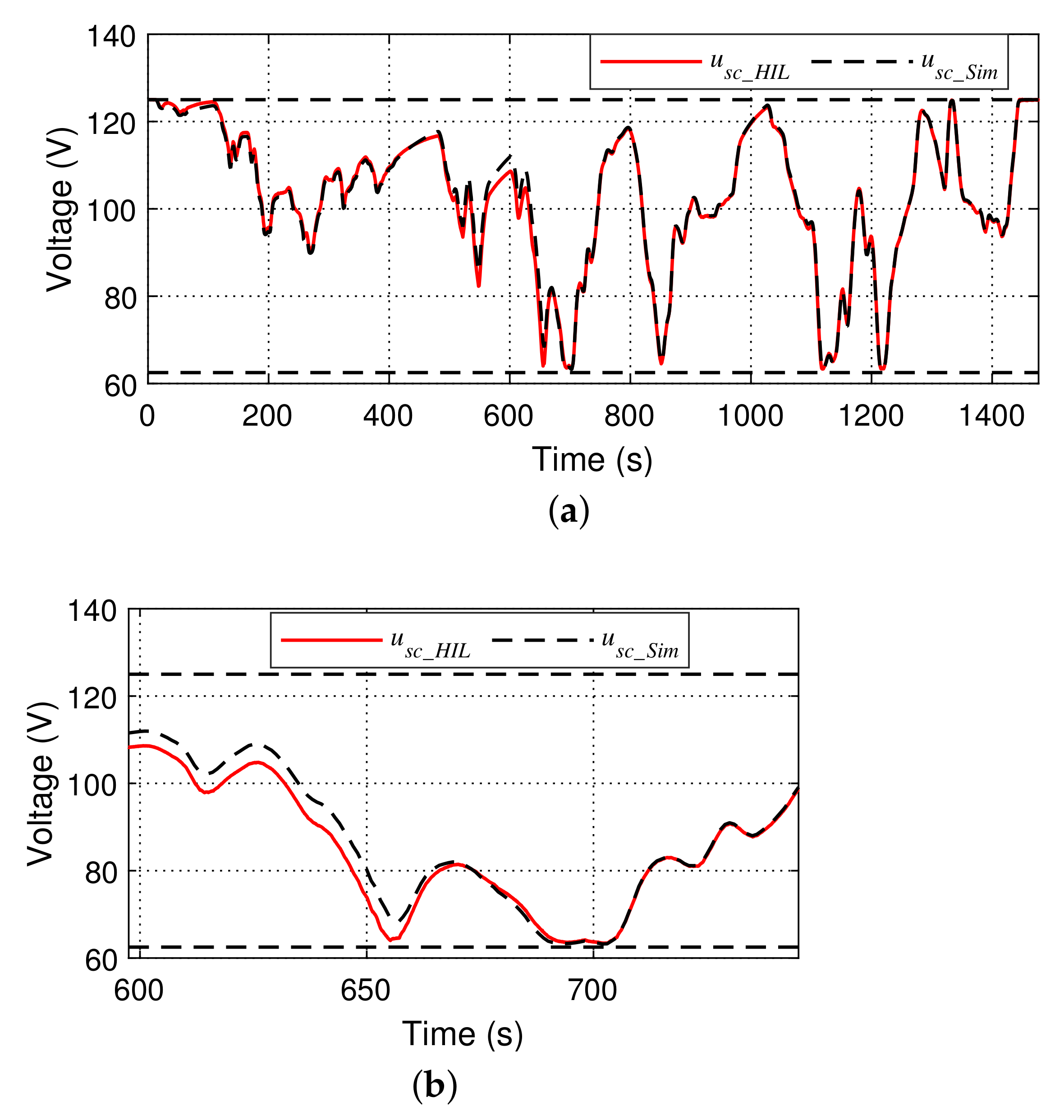
| Traction System |
|---|
| HESS |
| Specifications | Values | |
|---|---|---|
| EV (i-MiEV) | ||
| Vehicle total weight | 1250 kg | |
| Gear box ratio | 7.065 | |
| Wheel radius | 0.2844 m | |
| Aerodynamic standard | 0.8295 m2 | |
| Rolling friction coefficient | 0.02 | |
| Air density (at 20 ) | 1.25 kg/m3 | |
| IPMSM | ||
| Maximum power | 49 kW | |
| The number of polar pairs | 4 | |
| Pole flux | 0.06 Wb | |
| Stator inductance | 140 µH | |
| 210 µH | ||
| Windings’ resistance | 12 m | |
| Battery module (LEV50 Li-ion) | ||
| Cell storage capacity | 50 Ah | |
| Cell OCV | 3.7 V | |
| Cell OCV (at 20% SOC) | 3.06 V | |
| Cell resistance | 1.7 m | |
| Number of cells in series | 88 | |
| Number of cells in parallel | 1 | |
| SC module (NESSCAP EMHSR-0062C0-125R0SR2) | ||
| SC module nominal voltage | 125 V | |
| SC module nominal capacitance | 62 F | |
| SC module internal resistance | 10 m | |
Publisher’s Note: MDPI stays neutral with regard to jurisdictional claims in published maps and institutional affiliations. |
© 2021 by the authors. Licensee MDPI, Basel, Switzerland. This article is an open access article distributed under the terms and conditions of the Creative Commons Attribution (CC BY) license (https://creativecommons.org/licenses/by/4.0/).
Share and Cite
Nguyen, H.-L.T.; Nguyễn, B.-H.; Vo-Duy, T.; Trovão, J.P.F. A Comparative Study of Adaptive Filtering Strategies for Hybrid Energy Storage Systems in Electric Vehicles. Energies 2021, 14, 3373. https://doi.org/10.3390/en14123373
Nguyen H-LT, Nguyễn B-H, Vo-Duy T, Trovão JPF. A Comparative Study of Adaptive Filtering Strategies for Hybrid Energy Storage Systems in Electric Vehicles. Energies. 2021; 14(12):3373. https://doi.org/10.3390/en14123373
Chicago/Turabian StyleNguyen, Hoai-Linh T., Bảo-Huy Nguyễn, Thanh Vo-Duy, and João Pedro F. Trovão. 2021. "A Comparative Study of Adaptive Filtering Strategies for Hybrid Energy Storage Systems in Electric Vehicles" Energies 14, no. 12: 3373. https://doi.org/10.3390/en14123373
APA StyleNguyen, H.-L. T., Nguyễn, B.-H., Vo-Duy, T., & Trovão, J. P. F. (2021). A Comparative Study of Adaptive Filtering Strategies for Hybrid Energy Storage Systems in Electric Vehicles. Energies, 14(12), 3373. https://doi.org/10.3390/en14123373








